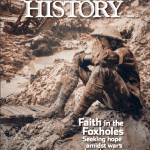Across the political spectrum, most Americans would automatically describe the country’s religious heritage as “Judeo-Christian.” Rarely, though, do they think about the origins of this term, or how exceedingly odd it would have appeared before the 1950s (and still does to many non-Americans). In fact, the Judeo-Christian concept has a highly political origin, and was a deliberate response to ugly conflicts that had badly tainted the simple “Christian” label.
The Judeo-Christian label apparently originated with George Orwell, writing as recently as 1939, and it was popularized by several events of the 1950s. In 1952, critically, Dwight Eisenhower declared that “our form of government has no sense unless it is founded in a deeply felt religious faith, and I don’t care what it is. With us, of course, it is the Judeo-Christian concept.” (That second sentence is often omitted when the well-known speech is quoted, making Ike sound foolish and woolly-minded). The phrase was further popularized in 1954 when “under God” was added to the Pledge of Allegiance, and in 1956, the nation’s official motto became “In God We Trust.” So which God? Why, the Judeo-Christian one. Who else? In the same years, the Judeo-Christian concept became a foundation for the emerging notion of American civil religion.
“Judeo-Christian” made multiple sense in the context of the time, because it was a good reflection of American society, or at least in the cities. In 1955, Willi Herberg wrote his famous analysis of American religious life, divided into Protestant, Catholic and Jew. Also, in the context of the Holocaust and the Nazi era, Judeo-Christian sounded like a ringing endorsement of mutual tolerance and harmony. The triumph of Judeo-Christian reflected the campaigning of various movements formed to promote Christian-Jewish understanding. Such groups originated in the 1920s, and in 1938 they developed into the National Conference of Christians and Jews.
This story is reasonably well-known, but it omits a critical part of the story, and the critical urgency of redefining American religious identity in those years. Briefly, in the 1930s and 1940s, the label “Christian” had been widely appropriated by far Right sects. In that political context, the word Christian was not an assertion of faith or theology, but a confrontational rejection of Jews and Judaism. Obviously, such movements were a minority, but they were not insignificant, especially in the cities. Between 1938 and 1942, so-called “Christian” extremist movements proliferated, and some became dangerous and violent.
Do not misquote me here. I am not saying that American Christians in general were anti-Semitic, still less thuggish and terroristic. But a vocal minority of extremists certainly was, and as so often occurs, they made much more of a public splash than the peaceful and tolerant mainstream.
To understand all this, we have to grasp an idea that seems bizarre and marginal today, but which was very broadly held at the time, and from which everything follows. For much of the far Right in the 1930s, the Bolshevik Revolution that established the Soviet Union was a Jewish movement, part of a global Jewish campaign for world domination. Communism was therefore of its nature a Jewish cause, pledged to the destruction of Christianity, and the slaughter or enslavement of Gentiles. That religious character (they believed) became starkly obvious from 1936 onward with the outbreak of the revolution in Spain. This led to mass killings of Catholic clergy, and the destruction of churches and monasteries. For the American and European Right, this whole episode was the work of Jewish Communism, pure and simple. Gentiles and Christians were the pledged enemies of Jews and Communists.
In the mid-1930s, the global Communist movement popularized the phrase Popular Front, an alliance of Communist, Socialist and left-wing organization. In 1938, the same phrase was appropriated by the anti-Jewish and anti-Communist demagogue Father Charles E. Coughlin of Royal Oak, Michigan. For him, a Christian Front was needed urgently to confront the Jewish Front of Communism, the New Deal, and the Left.
Coughlin began his career as an exponent of the Catholic social tradition was who from 1931 onwards earned celebrity for his radio broadcasts supporting economic reform. His “National Union for Social Justice” claimed four million members nationwide at its height, and in 1936 the organization attempted to support an independent presidential campaign, through the Union Party. Thereafter the Coughlinites swung increasingly against Roosevelt and indeed against political democracy as such, largely under the influence of European events, and especially the Spanish war. Coughlin’s followers adopted the battle cry “Long live Christ the King,” which aligned them with the far-Right Catholic Action movements of several European and Latin American nations.
In 1938, Coughlin’s paper Social Justice began calling for the establishment of a paramilitary “Christian Front” in the United States, to combat Communism. Each “platoon” would comprise twenty-five men, and in turn formed part of larger “riflemen’s groups”, which would ultimately (he hoped) join a national army some five million strong. This was what Coughlin termed “the Franco way.” In New York City, the first Christian Front units were formed in semi-clandestine conditions during that Summer. They gained public visibility in late 1938, when Coughlin’s broadcasts and newspapers demonstrated a sharp turn to anti-Semitism. (He was also in contact with German intelligence, but that is another story).
As I have previously described, the Christian Front became a mass political movement, mainly appealing to Irish urban followers, some of whom became involved in anti-Jewish violence. (Germans and Italians were also involved). But the Christian Front was not the only example of its kind. As the far-Right sects boomed in the late 1930s, they could usually be identified by their use of three terms, in various combinations: Christian, National or American. These included, for instance, the Christian Mobilizers headed by Joe McWilliams, the Christian Youth for America, and the American Christian League. Besides Coughlin, the other critical far Right leader was William Dudley Pelley, founder of the Silver Shirts, whose central demand was the transformation of the United States into a “Christian Commonwealth.”
“Christian” language dominated the propaganda that such groups spread very widely in the cities between 1938 and 1942, in campaigns that I described at length in my book Hoods and Shirts. Many of the handbills and stickers of the time survive, and the same themes emerged repeatedly. One Philadelphia leaflet demanded a purge of the public schools: “Let us have Christian schools with Christian teachers for Christian children . . . Communism is Jewish … the Jew Deal has ruined our industries … Who has the job you ought to have? A Jew who wants war?” Speaking of the Spanish war, one extremist leader in Philadelphia asserted that, “There was over a million Christians over there who had been slaughtered and the Jews engineered that, in my humble opinion, that Spanish revolution.”
The alleged Jewish onslaught demanded defensive measures, including commercial boycotts: “Don’t strike the Jew; Don’t be rude to the Jew; and Don’t BUY from the Jew.” Jewish owned shops were placarded with signs reading “Buy here and help Communism”; or “Help Zionism send all Jews to Palestine.” Bystanders were urged to sign a pledge to “Buy Christian”, to “Live Christian, Vote Christian, and Trade Christian.” This campaign exploited Christmas, viewed as a central Christian holiday that had been exploited by Jewish merchants and businessmen for their own sordid profits. In December 1939, the Christian Front ordered the printing of 100,000 leaflets and handbills on the theme of “Buy Christian for Christmas.”
If you lived in a big American city, these signs were hard to miss. In New York, Boston, and Philadelphia, they were an epidemic.
We might think that such campaigns would have collapsed after the US entry into war in 1941, but they assuredly did not. On December 8, the day after Pearl Harbor, the National Legion of Mothers of America demanded an early peace on the grounds that the war meant that “Christians will spill their blood for the Jews.” While the US was at war with Nazi Germany, anti-Semitic campaigning continued unchecked, and might actually have increased in some areas. Now, though, the focus of activity shifted to the work of far Right women’s movements, such as the National Blue Star Mothers. (Note that “National” word again, recalling Franco’s Nationalists).
Leaflets distributed on the streets of major cities appealed to “Christian Mothers.” Citing the most recent total for US casualties, they asked “Is this the price you are paying for Jewish revenge?” . . . ”Must we have another million Christian casualties just to make Stalin the world dictator instead of Churchill or Roosevelt?” National Blue Star literature claimed that the war was fought for Jewish interests, and constituted a “Jew Holy War”, in which gullible Christians served as foot-soldiers. Jews (they said) rarely served in the armed forces, and the only Gentiles who received preferential treatment were blacks, whose units received special warning of Axis assaults.
When Gerald L. K. Smith set up his influential anti-Semitic news-sheet in 1942, it bore the title The Cross and the Flag.
Not only did the ultra-Right survive Pearl Harbor, it actually revived powerfully after the collapse of Nazism in 1945. Old-time militants strove to resurrect the Christian Front, organizing anti-Jewish street meetings in the traditional style. Directly recalling the Coughlin era were extremist Catholic priests like Edward Lodge Curran and Arthur Terminiello. Facing the threat of desegregation, the Klan also returned in full force, and allied with far Right leaders like Gerald Smith and the activists of the “Mothers Movement.” This was the point at which the Klan made the historic attempt to move away from its traditional anti-Catholic focus to a broad “Christian” alliance, with Protestants and Catholics united under its fiery cross.
Just like before the war, the anti-Semitic rhetoric of the late 1940s was avowedly “Christian.” Much of the activism involved veterans’ groups, and the Christian Veterans of America became a vanguard of the Rightist coalition. It was a Terminiello speech to the Christian Veterans (and the ensuing riot) that led to a celebrated Supreme Court decision on free speech, Terminiello v. City of Chicago (1949).
So pervasive was anti-Semitism that by 1947, Hollywood was induced to tackle the explosive topic in two notable films, Gentleman’s Agreement and the noir classic Crossfire.
By this time, if someone claimed to be a member of a hypothetical “Christian Party” or “Christian League,” that might mean a harmless and well-intentioned religious group, but you could never be sure if an anti-Semitic motivation lurked beneath that harmless phrase. A National Christian or American Christian label gave the game away. To that extent, Christian, National and American all became highly suspicious political words, and Christian in this context signified “Gentile.” That was appalling news for the vast majority of American Christians who used such terms with no intent of bigotry.
The problem really demanded a new political formulation, and that opened the way for the work of the National Conference of Christians and Jews. And at that point, enter “Judeo-Christian.”
There is a separate story here, which is how Christian thinkers came to criticize doctrines of supersessionism and replacement theology. Some Biblical scholars, meanwhile, came to speak of the “Hebrew Bible,” rather than the Old Testament. But that is the theme of another blog.
Anti-Semitism continued after 1945, and of course is still a potent force today, but the “Christian” political dilemma largely faded. Later generations of religious activists made very sure to use language that appealed across the Judeo-Christian spectrum. That was true of the Moral Majority of the 1980s and the Christian Coalition of the 1990s. (Despite its name, the Coalition sought alliances with conservative Jews). Such movements usually adopted fiercely pro-Zionist stances. The “Christian” political landscape had changed utterly.
One final thought. As the United States acquires a larger Muslim population, will Judeo-Christian language itself seem outdated and exclusive? Controversial as it seems right now, maybe we will shift to speaking of “Abrahamic”?













